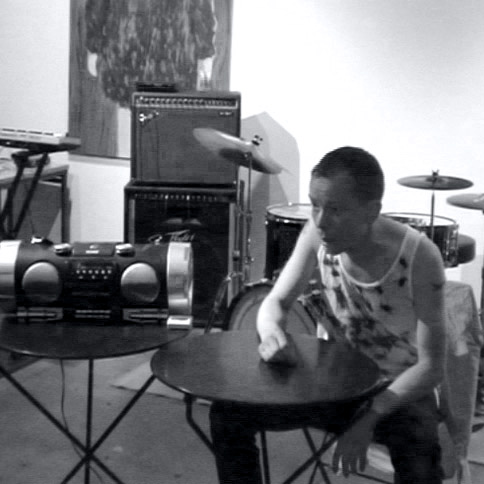Schizoanalytic practice. Performance at the Gallery Jangva. Event organized by Jangva and curated by Tiina Nevanperä. Camera Herman Vogelpoel. August 28th, 2011.
CONCLUSION
I have described some artistic processes which revolve around minute and often nondiscursive matters. These processes may seem, to some extent, failures or cultivated disasters. It may appear that the aspiration of these projects is to conjure up ridicule and destructive annihilation, in a similar manner to the performances of some historical avant-garde artists or groups. If this were the case, it would make this practice anachronistic. Moreover, it would debilitate the constituent link between performance art practice and contemporary notions of the performative in terms of political subjectivity. For me, however, such practice is not an articulation of an artistic problem, per se. These issues are not reserved only for the minor subject of performance art, but they should be appropriated into any area which deals with the question of performance or production of meaning from nondiscursive potentialities. Notwithstanding my emphasis on the ‘off the cuff’ nature of performance practice, my aim is to link such a practice with other performances, as well. By this I mean those performances which Paolo Virno identifies when he writes that “every political action is virtuosic,” or those McKenzie introduces with the idea of controlled performances, as discussed earlier. (Virno 2004, 53) A sponge subjectivity is a virtuoso, bestowing potential onto his or her existential territory; he or she is a homo œconomicus – virtuosic, performing subjectivity, fitted into the neoliberal economy.
I have tried to estimate the different levels of contamination, which occur in different forms and magnitude. The nature of contamination is corruptive and infective [21]. Moreover, contamination is abhorred in present everyday practice, as if it would be the reminder of our corporeality. Contamination denotes smell, decay, and the interconnectedness between humans and non-humans in the shared milieu. While describing the appearance of Baroness Elsa, Jones associates Baroness’ malodorous appearance with the ragpicker, which
“can provoke a radical sense of dislocation […] the person who encounters the ragpicker or détraqué suddenly calls into question her own corporeality, her coherence, her methods of making sense of the world [and] the confrontation can be very scary.” (Jones 2004, 199)
In my argument, schizoanalytic performance practice emphasizes this incomprehensible pressure of present contaminations and reflects on how our subjectivity is in a sense nothing but a hyper complex amalgamate of contagions, affecting the three aspects of plasticity; giving, receiving and annihilating form. Such practice may not produce similar affects as the avant-garde proto-performance by The Baroness, but it may dislocate the witness from his or her trust in essential subjectivity. This is the other side of sponge, the virtuoso of neoliberal capitalism. It is the shadow, or in other words the nondiscursive, virtual potentiality, which appears only in the form of affects, never to be fully recognized. It is a nondiscursive contamination, which consecutively will be given form through the Machines of the Real. Eventually, nondiscursive potentiality alters the existential Territory of a subject or a group. The artistic practice is not only confined in the territory of avant-garde or mainstream, but is a part of the production of subjectivity, which is a transindividuation process. It is for this reason that I find such a practice, dealing as it does with nondiscursive potentiality, to have a significant role in conversing with the political agenda of neoliberal capitalism, specifically when it aims to capture the full potentiality of our everyday existence. Neoliberal capitalism diffusely aims to contaminate subjectivity and its performance by producing types, which in a subdued manner can be considered as not so distant from what Lacoue-Labarthe and Nancy have criticized as the totalitarian use of plasticity [22]. In this light, when the discursive nature of artistic practice incorporates the dual nature of nondiscursive potentiality – of being exploited or revered as an actuation of the new with difference – it is expressly a political task. It is an articulation of the contemporary political subjectivity.
Next section: Works cited
Previous section: Tell Me about Your Machines
[21] “[Freud] questioned the value of conceptualizing trauma on the model of an infectious foreign that automatically produces symptoms of inflammation, on the grounds that the organization of memory is far more complicated than such a causal analogy would imply.” (Leys 2000, 265)
[22] “With the idea that the nature and the finality of myth, or of the dream, is to incarnate itself in a figure, or in a type. Myth and type are indissociable. For the type is the realization of the singular identity conveyed by the dream. It is both the model of identity and its present, effective, formed reality. One attains, in this way, an essential sequence in the construction of myth: [Alfred] Rosenberg declares: "Freedom of the soul . . . is always Gestalt." ("Gestalt" means form, figure, configuration, which is to say that this liberty has nothing abstract or general about it; it is the capacity to put-into-figure, to embody.) "The Gestalt is always plastically limited." (Its essence is to have a form, to differentiate itself; the "limit," here, is the limit that detatches a figure from a background, which isolates and distinguishes a type.) "This limitation is racially conditioned." (Thus one attains the content of the myth: a race is the identity of a formative power, of a singular type; a race is the bearer of a myth.) "Race is the outward image of a determined soul" (M[yth of the Twentieth Century], p. 331; p. 559). This last trait is a leitmotif in Rosenberg and is also found, more or less explicitly, throughout Hitler's writing: a race is a soul, and in certain cases, a genial soul, [Mein Kampf (1925/1940), translated by Alvin Johnson et al., New York, pp. 403-4] in the sense that German romanticism gave to the word, within which individual differences remain, as well as individual geniuses, who better express and form the type.” (Lacoue-Labarthe and Nanci 1990, 306)
